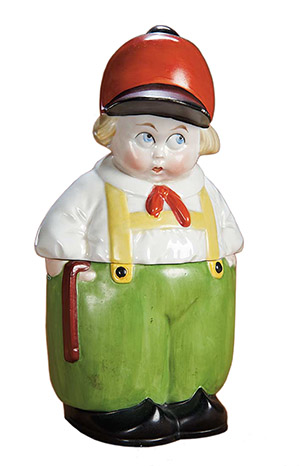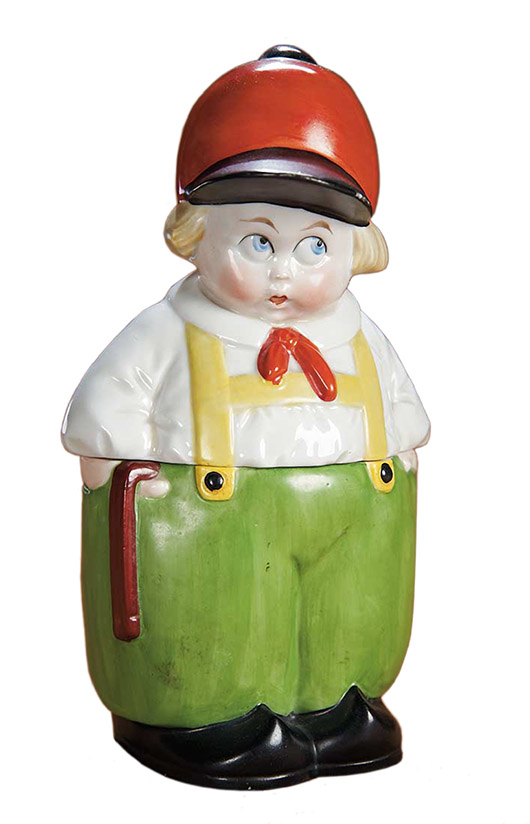
BEACHWOOD, Ohio – “Googly eyes” is a term that can mean two slightly different things. The meaning online refers to small, plastic pieces that look like round sandwiches with clear tops and a small, loose, round black piece inside. They are used to represent moving eyes in toys, dolls and puzzles. But to a collector of vintage dolls, toys and figurines, googly eyes means oversized, side-glancing eyes painted onto the piece. Or it can be the name for a doll with the googly eyes. The eyes give the face a comic look, and since most dolls with googly eyes have chubby cheeks and tiny mouths, the dolls seem friendly, even lovable. They were made starting in about 1912, and most were made in Germany. The bulk of them date from 1915 to 1925.
Grace Drayton’s drawings of children with googly eyes were published earlier and were used in cartoons, comic strips and children’s books. Doorstops, dolls, figurines and tableware also pictured her googly-eyed children. Her most famous characters with big, round eyes are Dolly Dimple, a paper doll, and the Campbell Kids.
Googly-eye dolls started to go up in price in the late 1990s, and kept rising in the early 2000s. A few bargains can be found today.
Q: I saw a large wooden storage cupboard labeled “Rare, Hornbeam” at an antique show. No one was nearby to tell me what that meant.
A: Hornbeam is the name of a tree that grows in England and central Europe. Similar trees grow in North America and Japan. United States hornbeam is sometimes called ironwood, musclewood or blue beech. But 40 types are grown in East Asia. They grow slowly, up to 75 feet high. The wood is light-colored, almost white, and has a patterned grain with flecks. Because it is so hard, it is rarely used for furniture. Instead, it’s used to make wheels, carving boards, tool handles and sometimes pegs, screws and even parquet flooring. The bark can be boiled and used as a medicine to relieve pain. Furniture made from hornbeam is expensive because the wood is rare, difficult to work with and has an attractive grain.
Q: I bought a set of 21 Hummel spice jars. They have a Hummel picture and the name of a spice on the front and a legend about the spice on the back. The bottom of each jar is marked “M.I. Hummel, ARS AG, Cham, Switzerland, 1987.” Below that is a symbol that looks like a lowercase “d” over “m” and “Made in Japan.” What is their value?
A: Danbury Mint sold Hummel spice sets from 1987 to 1992. The “d over m” mark is the Danbury Mint mark. The jars were made in Japan using designs by ARS AG, a Swiss company that holds rights to Sister Maria Innocentia Hummel’s original pictures and to illustrations of the figurines. The complete spice set includes 24 spice jars and a wooden spice rack. Danbury Mint sold the jars by mail on a subscription basis. The customer received one or two jars per month, and the spice rack was included with the set. In 1991 the company offered the jars for $19.75 each. A set is very difficult to sell, especially if some jars are missing. A complete set might bring $50. Your partial set would be worth less.
Q: My Parker 51 pen-and-pencil set is in its original black box. The caps are 14K gold. The set is in good condition. How old is it?
A: George Safford Parker founded the Parker Pen Co. in Janesville, Wis., in 1888. The Parker 51 pen was developed in 1939, the company’s 51st year. After testing it in other countries, it was introduced in the United States in 1941. The pen has a Lucite body and 14K gold nib. It was made in several colors, with slight design changes throughout the years. The Parker 51 was made until about 1972, and became the best-selling pen in the world. The company was bought by Gillette in 1993 and became part of Newell Rubbermaid in 2000.
Q: Is there a market for old used jeans? My sentimental mother kept the jeans I wore when I was a toddler, and I’m now 64 years old. They have an 18-inch waist and 14-inch inseam. The Levi’s tag is red, not orange, so I wonder if these are the real thing.
A: Jeans were first made in 1873 by Levi Strauss & Co. Most Levi’s have a red tab, or tag. The orange tab was used on a line of Levi’s made from 1969 into the 1970s, and recently was re-introduced as a retro line. Levi Strauss established a wholesale dry-goods business in San Francisco in 1853. He and Jacob Davis were granted a patent on a method of fastening pocket openings with rivets in 1873, and they began making denim “waist overalls” (jeans) with copper rivets. If the name “Levi’s” on the tab on your jeans is in all caps, your jeans were made before 1971. This is known as the “Big E” tab. Some vintage jeans have sold for high prices in the past, especially in Japan, but there is not as much interest in children’s jeans.
Tip: Wash your hands or wear cotton gloves before handling books, textiles or paper artifacts.
Take advantage of a free listing for your group to announce events or to find antiques shows, national meetings and other events. Go to the Calendar at Kovels.com to find, publicize and plan your antiquing trips.
Terry Kovel and Kim Kovel answer questions sent to the column. By sending a letter with a question, you give full permission for use in the column or any other Kovel forum. Names, addresses or email addresses will not be published. We cannot guarantee the return of photographs, but if a stamped envelope is included, we will try. The amount of mail makes personal answers or appraisals impossible. Write to Kovels, Auction Central News, King Features Syndicate, 300 W. 57th St., New York, NY 10019.
CURRENT PRICES
Current prices are recorded from antiques shows, flea markets, sales and auctions throughout the United States. Prices vary in different locations because of local economic conditions.
- Gathering basket, woven splint, white oak, round, ribbed, bentwood handle, patina, 9 1/2 x 10 1/2 inches, $70.
- Fire helmet, aluminum, high eagle, blue, red painted metal front shield, Ladder 1, lieutenant, Cairn’s, circa 1897, $315.
- KPM lithophane lampshade, five panels, embossed women, children, black, white, circa 1890, 6 1/2 inches, $355.
- Irish silver ladle, scalloped shell-shape bowl, circa 1762, 13 3/4 inches, $500.
- Carpenter’s plane, walnut block, whalebone inlay, 10 1/2 inches, $560.
- Hilda baby doll, Kestner 245, bisque head, sleep eyes, teeth, composition, white lace bonnet, dress, 16 inches, $790.
- Kalo silver bracelet, flowers, three green stones, 6 inches, $815.
- St. Patrick’s Day candy container, composition, standing man, red hair, top hat, pipe, suit, cane, 10 inches, $950.
- Umbrella stand, iron, standing man, top hat, holding shillelagh, Ireland, circa 1865, 29 x 16 inches, $2,090.
- Music cabinet, lift top, carved front, hinged handles, green interior, C. Rohlf, 36 x 11 inches, $9,375.
“Kovels’ A Diary: How to Settle a Collector’s Estate” is our new week-by-week record of the settlement of an estate, from your first days gathering legal papers to the last days when you’re dividing antiques among heirs and selling everything else. How to identify pottery, jewelry and other popular collectibles. Tips on where and how to sell furniture, jewelry, dishes, figurines, record albums, bikes and even clothes. We include lots of pictures and prices, and explain the advantages of a house sale, auction, selling to a dealer and donating to a charity. Learn about how to handle the special problems of security and theft. Plus a free current supplement with useful websites, auction lists and other current information. Available only from the Kovels for $19.95, plus $4.95 postage and handling. Order by phone at 800-303-1996; online at www.kovels.com; or write to Kovels, P.O. Box 22900, Beachwood, OH 44122.

ADDITIONAL IMAGE OF NOTE



